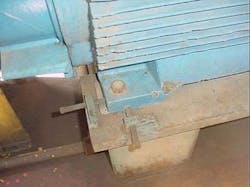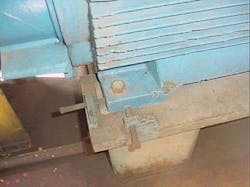Pump to Motor Alignment
by Robert L. Matthews
Most motor bolt bound issues I see today are from pipe strain. The pipe has moved over time and reinstalling the pump leaves the pump centerline off-center to the base centerline. The pump should be centered on the base to maintain design operating position.
Pipe strain is an age-old problem addressed in many ways over the years but that still exists and causes many undesirable problems. The method of determining pipe strain has been to place a dial indicator on the pump coupling and tighten the piping to the pump flanges, while also monitoring the dial indicator at the same time for movement at the coupling. If the dial indicator moves more than 0.002", there’s unacceptable pipe strain. That has worked for years.
I’m a bit picky about reliability. Think about a 0.002" coupling movement and what’s between the coupling and pipe nozzles, then ask: How much torque makes that bearing and shaft movement? Often, it might be a root cause to a failure. The real issue I want to point out is many motor installations are slowed down because the motor is bolt bound. When most motors are found bolt bound, maintenance is instructed to shoulder the bolts, drill the motor foot holes larger – or both. Shouldering the bolts is to machine the bolt where the motor foot contacts the side of the bolt. This allows the motor to shift more to one side. Over-drilling foot holes does the same thing. This all takes extra time and can weaken the hold-down process – and we pay to do work wrong.
I’m talking about pipe strain and motor bolt bound issues that appear to be different and are, but a lot of bolt bound motor work is eliminated when pipe strain isn’t causing the pump to be off the centerline of the pump base. Other causes of driven equipment being off-center are a badly drilled base (usually found during the original installation) and/or an installation that didn’t include centering the driven equipment. To have a good shot at successful alignment, you need a good, strong, flat engineered base on which the driven equipment is centered. Still, even with good bases, time, heat, vibration, subsidence and other environmental issues cause damage. In the case of base movement or damage, it’s best to replace the base to new engineered specs when shutdowns allow you to do the change. Ask – does your alignment procedure have a step to check if the pump is on the base centerline and, if not, make the obvious choice. Obviously, you would check the pump-to-base centerline if the motor is bolt bound. When we drill motor feet and shoulder bolts, we’re taking two wrongs to make it right; so go back to the pump or other driven equipment and do what can be done to start the alignment with the driven equipment centered on the base.
We know what to do to correct bolt bound motors and still can’t always correct the issue for now, due to time, cost or other constraints. This is when we implement a few additional things to better operate with larger-than-normal motor bolt holes and shouldered bolts. Use wider heavy equipment washers to help with the bolt hold-down and to assure downward force of the bolt doesn’t shift to one side and misalign the motor to the driven equipment. Schedule alignment checks for later to verify the equipment is still aligned, or check the alignment with vibration readings. Lock the motor alignment jacking bolts at a set distance from the motor feet, so a feeler gauge can measure any movement that might take place. And always write a work-order to correct the bolt bound motor problem at the first available opportunity.
About the Author: Reliability manager for Houston-based Royal Purple Ltd., Bob Matthews has 35-plus years of pump industry experience – from hands-on to supervision – in plant maintenance management, consulting and training. He has taught advanced pump classes for companies like Exxon, Phillips, Westinghouse as well as Auburn, University of Alaska, LSU, the Vibration Institute, ASME and FSA.

